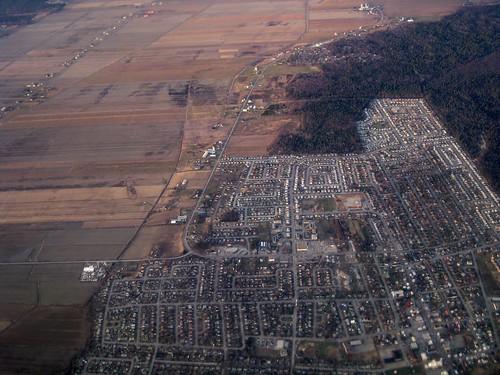On June 1st, Quebec’s national assembly passed bill 58, a law requiring Montreal’s Metropolitan Community (CMM) to draft a “metropolitan plan” for Greater Montreal by Dec 31, 2011.
The CMM is composed of 82 municipalities, including the biggies like Montreal, Laval and Longueuil. When it was formed in the year 2000, the CMM was mandated to create a detailed master plan for land-use in the metropolitan region by 2005. Then the deadline was pushed to 2006, then 2008, then seemingly forgotten.
Now bill 58 is intended to rope in the delinquent municipalities, but has also lightened the assignment: Rather than requiring a detailed land-use plan for the entire region, the province is only asking the island and off-island municipalities to agree on some broad directives. Bill 58 leaves more authority, including a greater say in regional planning, in the hands of the individual municipalities and MRCs (Municipalités régionales de comptés).
A metropolitan plan is an essential tool to ensure that transportation, environmental protection, agriculture and urban form don’t come into conflict within the region. But the urban centres, suburbs and villages often have competing views of what’s best. For instance, suburbs north of the island were in favour of extending highway 25 while the city of Montreal would have preferred to improve commuter trains.
Unfortunately, bill 58 means that the 82 municipalities don’t really have to lay aside their differences and come together to plan with the big picture in mind as they would have had to according to the 2000 mandate.
But at least the new law promises to break the standstill.
In April 2009, the Auditor General blasted the CMM for failing to put forth coherent transportation vision for the metropolitan region. The provincial ministry of transportation is set to pour $5 billion into transportation in the region over the next 5 years despite the fact that their information about urban development patterns is a couple decades out of date.
Meanwhile, the Farmers’ union fears that the looser approach to metropolitan planning will make it easier for municipalities to chip away at the amount of land zoned for agricultural use. However, they add that the metropolitan plan is still better than nothing. They have called for a freeze on de-zoning until the CMM’s plan is in effect. There is enormous pressure to dezone farmland as property values have tripled in the past 3 years in some off island suburbs.
The Institut de Politiques Alternatives de Montréal (IPAM), led by Phyllis Lambert and friends, recently published thier recommendations for the metropolitan plan (not yet available online).
Interestingly, the IPAM signatories note that the distinction between the urban centre and the suburbs is becoming obsolete: some parts of the city of Montreal are further from the downtown core than neighbouring towns like Laval and the South Shore. The city is no longer characterized by downtown employment surrounded by bedroom communities – these days suburbs compete among themselves to attract jobs and residents. Social problems that were traditionally associated with the gritty inner city are cropping up in suburbs, and some suburbs are falling on tough times as the downtown core is gentrifying. And, above all, the region as a whole is in competition with other metropolitan areas across North America to attract employers and residents.
Their suggestions for the plannign process are pretty basic:
1. Public consultation: The plan should be founded in a thorough public consultation with stakeholders throughout the territory.
2. Integrate transportation and land-use planning: The CMM’s plan should work with the AMT to take into account existing and planned regional transit, and focus on densifying development around transit axes.
3. Sustainable development: the metropolitan plan should establish “performance criteria” rather than enforce strict norms, in order to allow autonomous local development withing a framework of broad sustainability objectives.
4. Evaluation criteria: the plan should include quantitative and qualitative criteria to evaluate its progress and the contribution of each MRC and municipality.
You can read another critique of bill 58 from the president of the Ordre des urbanistes du Québec, in an interview with the Conseil régional de l’environnement.
Of course, I’d probably be more in favour of local planning autonomy if Montreal did not have a majority vote on the CMM. Montreal still has a slim majority of the population (52%), at least for the time being. So let’s get this done before Laval takes over…
Image: farmland, woodlands and suburban development intersect in Laval. Photo taken from an airplane in April 2009.

